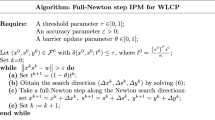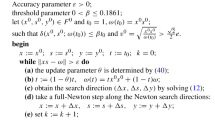Abstract
Nonlinear complementarity and mixed complementarity problems arise in mathematical models describing several applications in Engineering, Economics and different branches of physics. Previously, robust and efficient feasible directions interior point algorithm was presented for nonlinear complementarity problems. In this paper, it is extended to mixed nonlinear complementarity problems. At each iteration, the algorithm finds a feasible direction with respect to the region defined by the inequality conditions, which is also monotonic descent direction for the potential function. Then, an approximate line search along this direction is performed in order to define the next iteration. Global and asymptotic convergence for the algorithm is investigated. The proposed algorithm is tested on several benchmark problems. The results are in good agreement with the asymptotic analysis. Finally, the algorithm is applied to the elastic–plastic torsion problem encountered in the field of Solid Mechanics.


Similar content being viewed by others
References
Leontiev, A., Huacasi, W., Herskovits, J.: An optimization technique for the solution of the signorini problem using the boundary element method. Struct. Multidiscip. Optim. 24(1), 72–77 (2002)
Glowinski, R., Lions, J., Trémolières, R.: Numerical Analysis of Variational Inequalities, vol. 8. North-Holland, Amsterdam (1981)
Judice, J., Soares, M.: Solution of some linear complementarity problems arising in variational models of mechanics. Investigaç. Operac. 18, 17–31 (1998)
Chapiro, G., Gutierrez, A., Herskovits, J., Mazorche, S., Pereira, W.: Numerical solution of a class of moving boundary problems with a nonlinear complementarity approach. J. Optim. Theory Appl. 168(2), 534–550 (2016)
Ramírez, A., Mazorche, S., Chapiro, G.: Numerical simulation of an in-situ combustion model formulated as mixed complementarity problem. Revista Interdisciplinar de Pesquisa em Engenharia—RIPE 2(17), 172–181 (2016)
Dirkse, S., Ferris, M.: Mcplib: a collection of nonlinear mixed complementarity problems. Optim. Method Softw. 5(4), 319–345 (1995)
Simantiraki, E., Shanno, D.: An infeasible-interior-point algorithm for solving mixed complementarity problems. In: Complementarity and Variational Problems: State of the Art, MC Ferris and JS Pang, eds., Philadelphia, Pennsylvania, pp. 386–404 (1997)
Dirkse, S., Ferris, M.: The path solver: a nommonotone stabilization scheme for mixed complementarity problems. Optim. Method Softw. 5(2), 123–156 (1995)
Daryina, A., Izmailov, A., Solodov, M.: A class of active-set Newton methods for mixed complementarityproblems. SIAM J. Optim. 15(2), 409–429 (2005)
Daryina, A., Izmailov, A., Solodov, M.: Numerical results for a globalized active-set Newton method for mixed complementarity problems. Comput. Appl. Math. 24(2), 293–316 (2005)
Liu, C., Atluri, S.: A fictitious time integration method (FTIM) for solving mixed complementarity problems with applications to non-linear optimization. Comput. Model. Eng. Sci. 34(2), 155–178 (2008)
Gabriel, S.: A hybrid smoothing method for mixed nonlinear complementarity problems. Comput. Optim. Appl. 9(2), 153–173 (1998)
Kanzow, C.: Global optimization techniques for mixed complementarity problems. J. Global Optim. 16(1), 1–21 (2000)
Herskovits, J.: A feasible directions interior point technique for nonlinear optimization. J. Optim. Theory Appl. 99(1), 121–146 (1998)
Herskovits, J.: A two-stage feasible directions algorithm for nonlinear constrained optimization. Math. Program 36(1), 19–38 (1986)
Herskovits, J.: A two-stage feasible direction algorithm including variable metric techniques for non-linear optimization problems. Ph.D. thesis, Inria (1982)
Herskovits, J., Mazorche, S.: A feasible directions algorithm for nonlinear complementarity problems and applications in mechanics. Struct. Multidiscip. Optim. 37(5), 435–446 (2009)
Mazorche, S.: Algoritmos para problemas de complementaridade não linear. Ph.D. thesis, Universidade Federal do Rio de Janeiro (2007)
Billups, S., Dirkse, S., Ferris, M.: A comparison of large scale mixed complementarity problem solvers. Comput. Optim. Appl. 7(1), 3–25 (1997)
McCormick, G.P.: Second Order Conditions for Constrained Minima, pp. 259–270. Springer, Basel (2014)
Bazaraa, M., Sherali, H., Shetty, C.: Nonlinear programming: theory and algorithms. Wiley, New York (2013)
Herskovits, J.: A feasible direction interior-point technique for nonlinear optimization. J. Optim. Theory Appl. 99(1), 121–146 (1998)
Gabriel, S.A.: Solving discretely constrained mixed complementarity problems using a median function. Optim. Eng. 18(3), 631–658 (2017)
Rheinboldt, W.: Some nonlinear test problems. http://folk.uib.no/ssu029/Pdf_file/Testproblems/testprobRheinboldt03.pdf (2003)
Sun, D., Han, J.: Newton and quasi-Newton methods for a class of nonsmooth equations and related problems. SIAM J. Optim. 7(2), 463–480 (1997)
Kojima, M., Shindoh, S.: Extensions of Newton and quasi-Newton methods to systems of PC 1 equations. J. Oper. Res. Soc. Jpn. 29(4), 352–374 (1986)
Herakovich, C., Hodge, P.: Elastic–plastic torsion of hollow bars by quadratic programming. Int. J. Mech. Sci. 11(1), 53–63 (1969)
Wagner, W., Gruttmann, F.: Finite element analysis of Saint–Venant torsion problem with exact integration of the elastic–plastic constitutive equations. Comput. Method Appl. Mech. Eng. 190(29), 3831–3848 (2001)
Stampacchia, G.: Formes bilinéaires coercitives sur les ensembles convexes. CR Acad. Sci. Paris 258(1), 964 (1964)
Brezis, H., Sibony, M.: Équivalence de deux inéquations variationnelles et applications. Arch. Ration. Mech. Anal. 41(4), 254–265 (1971)
Acknowledgements
We thank the anonymous reviewer and A. Chapiro for help in improving the text. Angel E. R. Gutierrez was supported in part by FONDECYT “Generación Científica—Becas Nacionales—Fortalecimiento de Programas de doctorado en universidades peruanas” under Award 217-2014. José Herskovits was supported in part by CNPq and FAPERJ. Grigori Chapiro was supported in part by FAPEMIG under Award APQ-01377-15.
Author information
Authors and Affiliations
Corresponding author
Additional information
Communicated by Ole Sigmund.
Rights and permissions
About this article
Cite this article
Gutierrez, A.E.R., Mazorche, S.R., Herskovits, J. et al. An Interior Point Algorithm for Mixed Complementarity Nonlinear Problems. J Optim Theory Appl 175, 432–449 (2017). https://doi.org/10.1007/s10957-017-1171-7
Received:
Accepted:
Published:
Issue Date:
DOI: https://doi.org/10.1007/s10957-017-1171-7
Keywords
- Feasible direction algorithm
- Mixed nonlinear complementarity problems
- Interior point algorithm
- Elastic–plastic torsion




